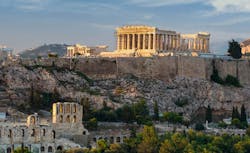Earlier this summer, I stumbled upon the old Simon & Garfunkel song Bookends, which starts, “Time it was, what a time it was. A time of innocence. A time of confidences…”
Wait, what? Hearing that made me stop to call up the lyrics on my phone. I had always thought that last word was “consequences.” After all, the song was written in 1968, arguably the most consequential year in modern U.S. history, at least before Covid. But sure enough, I was wrong.
Even so, it caused me to ponder the truly consequential time in which we now live.
The ongoing pandemic, of course, has been extraordinary and life-altering in so many profound ways, all around the globe. And this summer, as blistering heat reminds us everywhere that global warming was already an existential crisis even before the Coronavirus came calling, we are challenged anew to raise that alarm again, amid a cacophony of other still-blaring sirens.
But even as heated political and societal debates flared bitterly, and tragically, across the U.S. in June and July, the climate crisis still managed to grab its share of alarming headlines. Indeed, it was especially hard not to notice the unusual news this summer that London’s Heathrow Airport had temporarily had to close… because one of its runways was melting!
Of course, that record heat wave hit Europe just days after the U.S. Supreme Court handed down its bombshell 6-3 ruling in West Virginia v. EPA. The high court said the Environmental Protection Agency does not have the regulatory authority to push the U.S. power industry toward clean energy sources, including solar and wind power, to mitigate greenhouse gas emissions.
Writing for the court’s conservative majority, Chief Justice John Roberts argued, “Capping carbon dioxide emissions at a level that will force a nationwide transition away from the use of coal to generate electricity may be a sensible ‘solution to the crisis of the day.’ But it is not plausible that Congress gave EPA the authority to adopt on its own such a regulatory scheme.”
Plausible or not, the words “crisis of the day” do seem to minimize the undeniable climate emergency we all now face in 2022. But the even greater impact of this ruling is that it has now called into question the EPA’s authority to regulate, well, anything. And that may have a devastating and disruptive effect on our industry, in particular. Indeed, our July/August cover story, itself, is driven by recent EPA rulings governing the use of hydrofluorocarbons and guiding building owners to switch to A2L refrigerants that have lower Global Warming Potential (GWP).
As Jim Cika of the International Code Council tells us, there are very aggressive deadlines rapidly approaching for that switch-over, which has caused many in our industry to scramble. In light of the recent Supreme Court ruling, however, it now seems plausible that there will be new legal challenges on this issue, as well. Of course, that will cause still more delay, which also has consequences.
Even so, the engineering community is still pushing forward on climate, and it is thinking globally.
This October in Athens, Greece, ASHRAE will host its first International Building Decarbonization Conference, organized by the professional society’s new Task Force for Building Decarbonization. That task force is co-chaired by former ASHRAE presidents Don Colliver and Tom Phoenix, who joined us on our ‘HPAC On The Air’ podcast earlier this year. They told us then that as recently as last fall, they had started noticing a shift in the marketplace, where clients suddenly seemed “much more willing to talk about how to get to zero carbon.”
So, perhaps, the tide already has turned in our industry, to the point where scientifically foreseen consequences will drive more building owners' decisions… even if regulatory authorities no longer can.
##########
For more Editor's Notes columns, click here.
To comment or contact the author, e-mail him at [email protected].
About the Author
Rob McManamy
Editor in Chief
An industry reporter and editor since 1987, McManamy joined HPAC Engineering in September 2017, after three years with BuiltWorlds.com, a Chicago-based media startup focused on tech innovation in the built environment. He has been covering design and construction issues for more than 30 years, having started at Engineering News-Record (ENR) in New York, before becoming its Midwest Bureau Chief in 1990. In 1998, McManamy was named Editor-in-Chief of Design-Build magazine, where he served for four years. He subsequently worked as an editor and freelance writer for Building Design + Construction and Public Works magazines.
A native of Bronx, NY, he is a graduate of both the University of Virginia, and The John Marshall Law School in Chicago.
Contact him at [email protected].
